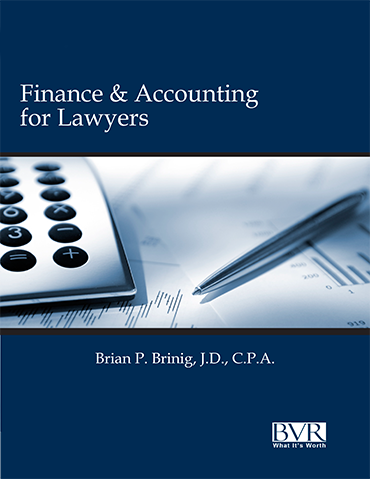Finance and Accounting for Lawyers
November 2011 Hardcover (313 pages)
Brian Brinig
Business Valuation Resources, LLC
The principles of accounting and finance directly extend to contract issues, torts, business and securities matters, taxation issues, partnership disputes, gift and estate matters, to name only a partial list. These areas of jurisprudence are often based significantly on substantive financial questions, and their measurement can be the heart of the entire matter. The application of broad accounting principles to countless business transactions requires an understanding of the objectives of financial reporting and the needs of the users of financial information.
Contrary to popular belief, accounting is not a mathematical formula or calculation, but rather an organized system that logically summarizes business transactions into useable information that is meaningful to management, creditors, business investors and other stakeholders. This text takes readers through the system of accounting and the development of financial statements. Complexities and limitations of accounting information are explored, culminating in a study of ratio analysis of financial statements to glean relevant insights. The objective of this introductory study of accounting is to provide a broad, workable knowledge base that will facilitate the use of accounting information as it relates to the practice of law.
The finance and valuation chapters present concepts and calculations of simple and compound interest, present value and annuities. In the area of business valuation, the reader is exposed to Revenue Rulings 59-60 and 68-609, two seminal rulings on business valuation issues as well as a complete example and explanation of a small business valuation analysis.
The text contains three chapters on damages covering definitions, legal concepts underlying damages analyses and classifications of damages (general, special, economic, non-economic and punitive). One chapter is devoted to personal economic loss calculations and another focuses on lost profits. Finally, the text concludes with a chapter on opinion evidence and expert testimony with consideration of the legal privileges applicable to experts and techniques for taking effective expert depositions and cross-examining experts at trial.
Table of Contents:
Introduction
A Quick History of Accounting
Introduction to Finance
Finance, Accounting and the Law
Accounting: An Introduction
Introduction
Overview
The Accounting Process
Generally Accepted Accounting Principle
Limitations of Accounting Information
Conclusion
Double Entry Accounting System
Introduction
The Transaction
The Account
Debits and Credits
Double Entry Accounting System
Recording a Transaction
Posting to the General Ledger
Preparing the Trial Balance
Finalizing the Bookkeeping Process and Preparing Financial Statements
Preparing Financial Statements
Closing the Books
Further Discussion
Proprietorships versus Corporations
The Relationship between the Balance Sheet and the Income Statement Conclusion
Accrual Accounting
Introduction
Accrual Basis Accounting
The Realization Principle—the theory behind revenue recognition
The Matching Principle—the theory behind expense recognition
Violating the Realization Principle and the Matching Principle
Cash Basis vs. Accrual Basis
Accounts Receivable and Revenue Recognition
Converting from Cash to Accrual and from Accrual to Cash
Accounts Payable and Expenses
Prepaid Items and Deferred Revenue
Another Deferred Item—Taxes
Conclusion
Fixed Assets and Depreciation
Introduction
Accounting for Fixed Assets
The Concept of Depreciation
The Mechanics of Depreciation Accounting
Methods of Depreciation
Gains and Losses on the Sale of Fixed Assets
Natural Resources and Depletion
Intangible Assets and Amortization
Conclusion
Inventory Accounting and Cost of Goods Sold
Introduction
The Business Cycle as It Relates to Inventory
Inventory—The Basics
Two Types of Inventory Accounting
Methods of Costing Ending Inventory under the Periodic Method
Comparison of the Differences in Methodologies
Errors in Inventory Accounting
Inventory in Manufacturing Companies
Conclusion
Financial Statement Analysis
Introduction
Concepts for This Chapter
Methods of Financial Statement Analysis
Analysis of Financial Statements
Profitability Ratios
Solvency, Liquidity and Leverage Ratios
Management and Activity Ratios
Conclusion
Introduction to Finance: The Time Value of Money
Introduction
Wealth, Capital and Money
The Time Value of Money: Interest
Definition of Terms for This Chapter
Simple Interest
Compound Interest and the Time Value of Money
The Concept of Present Value
Regular Mortgage Loan Calculations
Advanced Mortgage Calculations
The Amortization Worksheet
Ordinary Annuities
General Principles of Appraisal and Valuation of Businesses
Introduction
General Principles of Appraisal
Approaches to Determining Value
Standards of Value
Premise of Value
Valuing Small Businesses
Overview of the Business Appraisal Process
Possible Methods of Valuing a Business
Capitalization of Excess Earnings Method
Balance Sheet Review (Determination of Net Tangible Assets)
Adjustments Generally Required in the Analysis
Tax Consequences of Making Adjustments
Income Statement Review
Example: ACME Industries, Inc.
Excess Earnings Analysis
Conclusion
Chapter 9 Appendix A: Sample Appraisal Report
Chapter 9 Appendix B: IRS Revenue Rulings
IRS Revenue Ruling 59-60
Rev. Rul. 68-609 197
Damages
Introduction
Definition of Damages
Legal Concepts Underlying Damages
General Classifications of Damages
Specific Sub-Categories of Damages
Classifications and Categories of Damages
Spectrum of Damages Calculations
Damages in Contracts
Financial Concepts Underlying Damages Analyses
Conclusion
Personal Economic Losses
Introduction
Different Types of Losses
Other Important Issues in Personal Economic Loss Calculations
Lost Earnings/Lost Earnings Capacity Analysis
Lost Earnings and Lost Earnings Capacity Distinguished
Conceptual Framework of a Lost Earnings Capacity (“LOE”) Analysis
Graphic Presentation of a Lost Earnings Capacity Analysis
Sample Problem for Chapter 11
Calculating a Plaintiff’s Lost Earnings Capacity
Mitigating Earnings
Loss of Household Services
Medical, Life Care and Other Expenses
Conclusion of Example
Personal Consumption
Conclusion
Chapter 11 Appendix: Discount Rate Calculations
Discount rate theory
Selecting a proper discount rate
Net discount rate methodology
Conclusion of discounting conventions
Opinion Evidence and Expert Testimony
Introduction
Opinion Evidence
The Attorney’s Role Versus the Expert’s Role Generally, and the Financial Expert Specifically
Legal Privileges Relating to Expert Witnesses
Using and Opposing Experts in Litigation
Taking Effective Expert Depositions
The Effective Expert Deposition
Eliciting Opinion Evidence at Trial
Cross-Examination
Conclusion
Glossary/Appendix
